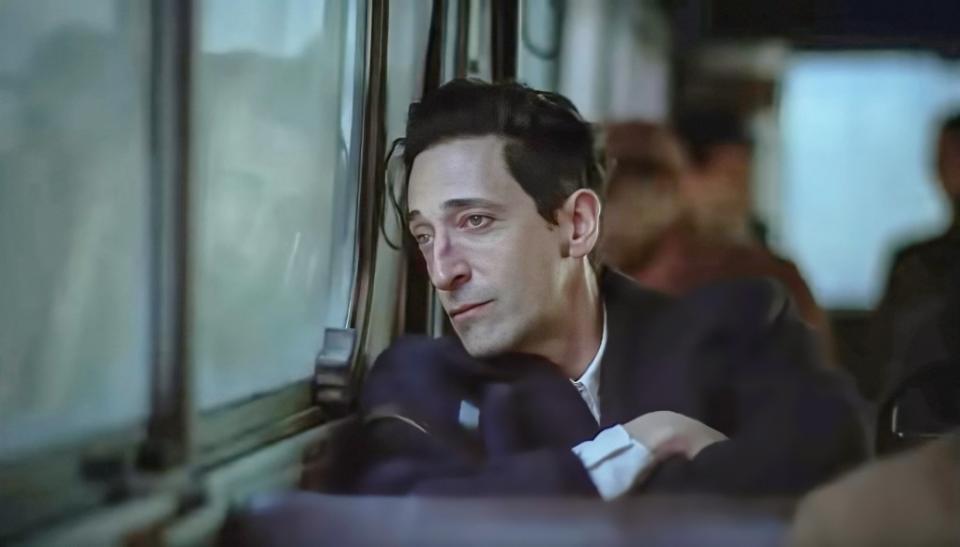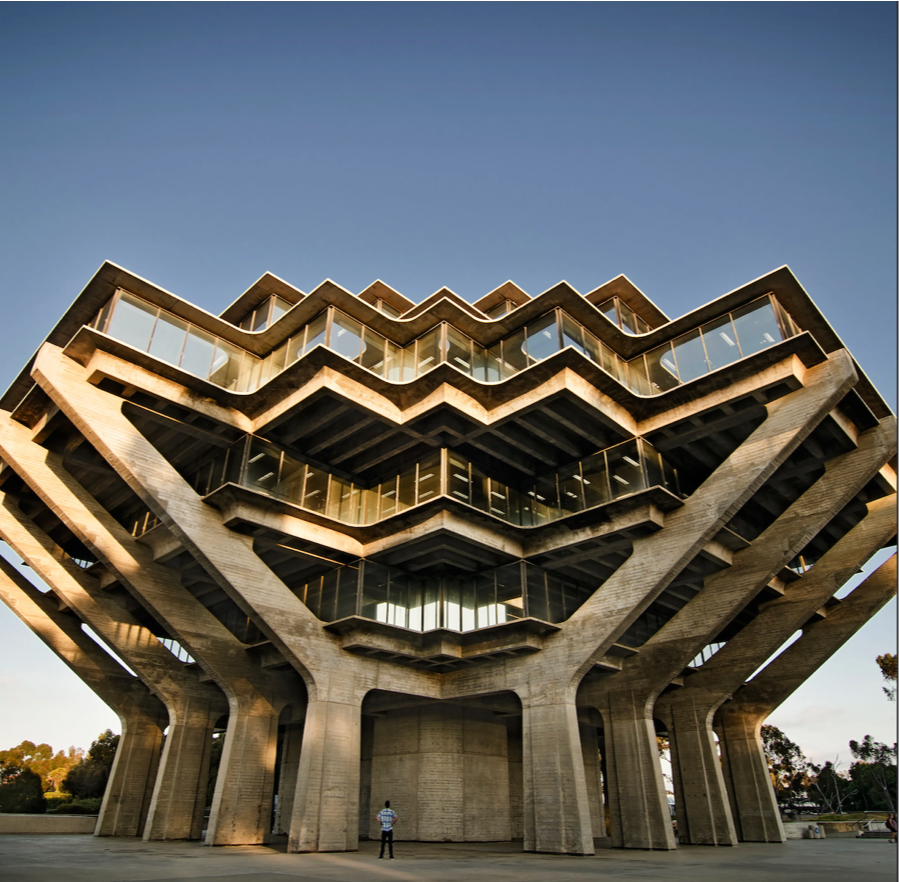Like the rest of the Wellington Architectural Cognoscenti, I went to a special Architectural Centre showing of The Brutalist in the weekend, because I do love me some nice hard concrete edges. Harder than 60mPa, if you know what I mean. It is a film that has got Hollywood talking, having been nominated for many Academy Awards, if that’s the sort of thing that blows your skirt up. And yes, Adrian Brody and his special schnoz do indeed take the cake / the coke / anything else you could get up there. There is some lovely acting by a few others, although oddly enough, not so good from Guy Pearce, whose lines came out all rather stiff and stilted. Not the only thing that came out stiff, mind you, but that is a story for another day.

The curious thing though, if I can tell you a bit about things without entirely giving away the entire plot, is that there is not really much architecture in it, and certainly next to bugger-all Brutalism. I don’t need to spell out what we mean by Brutalism, that much maligned word deriving from béton brut, which is not a Welsh Champagne but instead it is an architectural style featuring a lot of raw concrete. So you might be thinking that The Brutalist would be full of bare concrete, but you may be disappointed. Of course, if you hate bare concrete, you might be delighted. So what is the film about then? We can take the Brutal part as read, seeing as it appears to start off in a concentration camp. Who or what is the Brutalist? Is the film about an Ist or an Ism?

I’m not going to tell you. That would spoil the (considerable) surprise. There is in fact quite a lot of scenes in the Carrara marble mountain, which are suitably gorgeous, being full of white marble and all that buggery, but personally, I would not classify Brutalism as being made of slabs of gorgeous white marble, no matter how enigmatic the workmen are. Shades of Howard Roark and the Fountainhead come flooding back to mind, with that haughty lady slapping the face of the hero architect, as he refuses to debase his creation for the sake of the mighty dollar. This is like that – only much, much longer. So long, in fact, that it has a real intermission, like we used to have back in 1972, when I would rush out to get an icecream and jaffas. Having seen the film in Wellington, there were no jaffas, but I did get an icecream…
Intermission

the reviews are in. Here is a snippet from The Guardian, who say:
“Bold, confrontational and oversized in every way imaginable, Brady Corbet’s wildly ambitious three-and-a-half-hour-plus epic The Brutalist represents a near-perfect symbiosis of subject with film-making style. It’s a huge, uncompromising cinematic statement about the creation of a huge, uncompromising architectural statement. It’s a paean to purity of creative vision in the face of petty ignorance and tightened purse strings, of noble personal sacrifice in the name of art. The kinship between the misunderstood modernist architect who finds worlds of both opportunity and pain courtesy of the fickle whims of wealthy American philistines and Corbet, a former US child actor turned independent film-maker, is there for all who choose to see it.”
Well, yes, that is as maybe, except why do you need to make up a fictional architect when there are plenty of real architects and their real buildings? The film presents Laszlo Toth, a Hungarian Jew, and his trials and tribulations of getting work in America. Except that there was no Laszlo Toth – in reality, Toth is a heavy metal guitarist from Hungary. Just kidding, he is actually a Hungarian-born Australian geologist. Similarly, while the Van Buren (the benefactor?) in the film seems like a nice guy, he never existed either. You may be thinking instead of Eddie Van Buren, who was a football player of some repute a few years back.
Toth is alleged to be an amalgam of more famous, real architects like Marcel Breuer or Erno Goldfinger, either of whom would be far more interesting as a subject than Brody’s pained Mr Toth; while I guess Mr Van Buren is a stand-in for more famous, real client-people like Mr Kauffman of Falling Water fame. Why not make an actual film about actual real life clients, architects, cooks and gardeners? Frank Lloyd Wright springs to mind as a great topic – but would people ever believe what happened to HIM ? !! Need I go on….?






Looks like you’re stuck for an illustration, Nemo. You could try this…
https://blogger.googleusercontent.com/img/b/R29vZ2xl/AVvXsEhDyUMIJD5u87soggmbKh33INE3kEvmCfb6bocnAucU8TCyfaUAb28l-XFpm4679J0DwZeQiVGs_DMjGFeNj5Ko1MQs5TRn-gQm8BZFIgdOkbq7ENc5UgsbuJCXwWyUq33_DqevsDHyhsgT/s1600/Brut+Poster.jpg
Have you seen the film yet Starkive? I think you would like it.
Excellent idea Starkive. I’ve stolen it…
Forgive the off topic discussion, but in my view the most striking thing about that Geisel Library shot is how out of place that human looks in that shot. That is not a good thing for a library. While when viewed from a bit of distance away, it is a really striking building.
Then again it seems to be one of the more unflattering angles for a photo of that building.
No need to apologise Roeland – it is a really good point. There is also a dramatic lack of anything contextual around the building – it could be in a desert, or a car park, or possibly even in a city, but by this appearance, that looks unlikely. Got to keep in mind though, this is a building designed for the actual Doctor Seuss, and his books and brain were highly unusual – Cat in the Hat etc – so in a way you could argue that the Geisel is a remarkably restrained building compared to the books…? I think that one of the best things about Doctor Seuss was that he stimulated children’s minds – does this building also stimulate the heck out your neurons? It does mine !
TBH
The Geisel Library does not scream “Dr Seuss” to me, its simply an interesting Brutalist building,
The closest I’ve seen to a building that has “Dr Seuss” flowing through is the Hunterwasser Centre in Whangarei,,
You see that building and you know its something special, it could quite happily have a Dr Seuss collection housed there and EVERYBODY would know what the building was by simply looking at it…
Perhaps someone should suggest a Colab (we can only dream)
https://www.hundertwasserartcentre.co.nz/
Having seen the Hundertwasser building a few times during construction and then had the visitor experience after opening, I feel it’s a bit of a decorated shed – a box with wonky plaster bits and tiles stuck on. Once inside and faced with a really steep entry fee, I wouldn’t want to have mobility or even balance problems on the skate-park floors.
In its defence, and by the sounds of it you probably know more about this than me Starkive, the Hundertwasser building up in Whangarei was originally an existing Council building, was it not? So, a rectangular lump, on which they literally decorated with wonky plaster bits and tiles stuck on over the top. That is a very accurate description. Not at all what Friedrich would have wanted or would have done, but useful to reduce the cost.
Nope,.. Its a totally bespoke build…
While there was an existing old harbour board building on the site it was demolished and the site levelled before they began construction…
https://www.nzherald.co.nz/northern-advocate/news/site-cleared-now-piling-under-way-for-whangareis-hundertwasser-building/Y5WIHZNSV35WWEQ4PUN34YPJS4/
Google streetview has a good progression of the site
Original building
https://maps.app.goo.gl/b395sesZ7ATBC9Nw6
Site levelled and construction beginning
https://maps.app.goo.gl/NFBChg1QLqnn9Bkj6
New concrete shell
https://maps.app.goo.gl/Ck74P5L3xhh1ZX2h6
Finished version
https://maps.app.goo.gl/hNyTUR9nKYwvpogMA
The project started with a sketch by Hundertwasser to adapt a local government building in the Town Basin, but after the usual tortuous funding/political process they ended up knocking it down and starting again – presumably still with the footprint and maybe the basic outline of the original.
If you want to follow the whole saga, there’s a useful timeline here:
https://www.hundertwasserartcentre.co.nz/about/hundertwasser-art-centre/the-history-of-hundertwasser-art-centre/
In the initial stages there seemed to be lots of trips by council staff to Vienna, – just saying
The reverse also probably applies – Hundertwasser is probably the number one reason why Austrians and Wieners come to visit New Zealand. He is very popular in Vienna.
Oliver Wainwright, the Observer’s architecture critic, has written an excellent review:
“Backlash builds: why the architecture world hates The Brutalist“
“While the film world has showered the movie with five-star reviews – praising its heroic ambition, and drooling at the “authenticity” of shooting with hulking 1950s VistaVision cameras – architecture critics have been up in arms. “The Brutalist gets architecture wrong,” declared the Washington Post. It “perpetuates a colossal cliche,” fumed the Financial Times. Three prominent American architecture critics even got together to record a dedicated podcast, titled Why the Brutalist Is a Terrible Movie. For almost an hour, they railed against everything from the stereotypical depiction of the architect as a lone male genius to the Bauhaus-inspired graphic design of the credits, as well as (spoiler alert!) the idea that anyone would design a community centre and chapel based on the form of a Nazi concentration camp. At the screening I attended, one leading figure from the 20th-century heritage movement could barely contain their fury during the (very welcome) half-time intermission: “It’s just utter tosh!”
Interesting turn of events:
https://www.theguardian.com/film/2025/feb/18/the-brutalist-director-brady-corbet-says-he-has-made-zero-dollars-from-the-film
….”Corbet’s budget on the film was $9.6m (£7.62m), and a week after its premiere at the Venice film festival in August 2024, distribution rights were acquired by A24 for a similar sum, after a bidding war.
The Brutalist has so far taken $14.6m (£11.6m) in the US. In the UK, where it is being distributed by Focus and Universal, its current total is $3.2m (£2.5m). Rest of the world earnings to date stand at around $13.4m (£10.6m) for a global gross of $31.1m (£24.7m).
On his show, Maron pressed Corbet for clarification about payment for the film, to which he replied: “Yes. Actually, zero. We had to just sort of live off of a paycheck from three years ago.”…